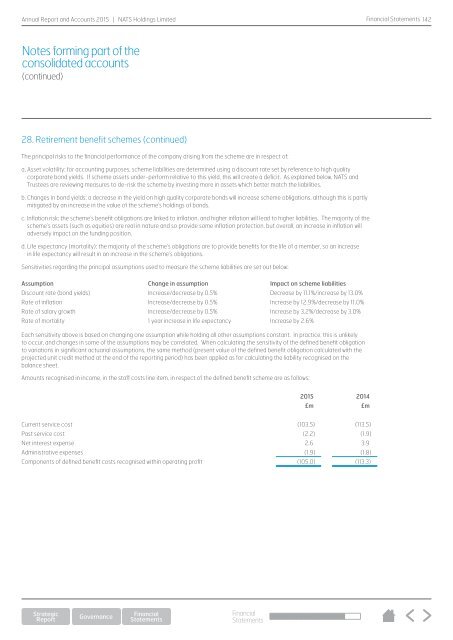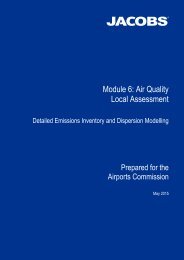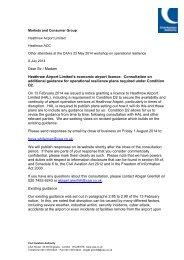NATS-Annual-Report-2015
NATS-Annual-Report-2015
NATS-Annual-Report-2015
Create successful ePaper yourself
Turn your PDF publications into a flip-book with our unique Google optimized e-Paper software.
<strong>Annual</strong> <strong>Report</strong> and Accounts <strong>2015</strong> | <strong>NATS</strong> Holdings Limited<br />
Financial Statements 142<br />
Notes forming part of the<br />
consolidated accounts<br />
(continued)<br />
28. Retirement benefit schemes (continued)<br />
The principal risks to the financial performance of the company arising from the scheme are in respect of:<br />
a. Asset volatility: for accounting purposes, scheme liabilities are determined using a discount rate set by reference to high quality<br />
corporate bond yields. If scheme assets under-perform relative to this yield, this will create a deficit. As explained below, <strong>NATS</strong> and<br />
Trustees are reviewing measures to de-risk the scheme by investing more in assets which better match the liabilities.<br />
b. Changes in bond yields: a decrease in the yield on high quality corporate bonds will increase scheme obligations, although this is partly<br />
mitigated by an increase in the value of the scheme’s holdings of bonds.<br />
c. Inflation risk: the scheme’s benefit obligations are linked to inflation, and higher inflation will lead to higher liabilities. The majority of the<br />
scheme’s assets (such as equities) are real in nature and so provide some inflation protection, but overall, an increase in inflation will<br />
adversely impact on the funding position.<br />
d. Life expectancy (mortality): the majority of the scheme’s obligations are to provide benefits for the life of a member, so an increase<br />
in life expectancy will result in an increase in the scheme’s obligations.<br />
Sensitivities regarding the principal assumptions used to measure the scheme liabilities are set out below:<br />
Assumption Change in assumption Impact on scheme liabilities<br />
Discount rate (bond yields) Increase/decrease by 0.5% Decrease by 11.1%/increase by 13.0%<br />
Rate of inflation Increase/decrease by 0.5% Increase by 12.9%/decrease by 11.0%<br />
Rate of salary growth Increase/decrease by 0.5% Increase by 3.2%/decrease by 3.0%<br />
Rate of mortality 1 year increase in life expectancy Increase by 2.6%<br />
Each sensitivity above is based on changing one assumption while holding all other assumptions constant. In practice, this is unlikely<br />
to occur, and changes in some of the assumptions may be correlated. When calculating the sensitivity of the defined benefit obligation<br />
to variations in significant actuarial assumptions, the same method (present value of the defined benefit obligation calculated with the<br />
projected unit credit method at the end of the reporting period) has been applied as for calculating the liability recognised on the<br />
balance sheet.<br />
Amounts recognised in income, in the staff costs line item, in respect of the defined benefit scheme are as follows:<br />
<strong>2015</strong> 2014<br />
£m £m<br />
Current service cost (103.5) (113.5)<br />
Past service cost (2.2) (1.9)<br />
Net interest expense 2.6 3.9<br />
Administrative expenses (1.9) (1.8)<br />
Components of defined benefit costs recognised within operating profit (105.0) (113.3)<br />
Financial<br />
Statements






